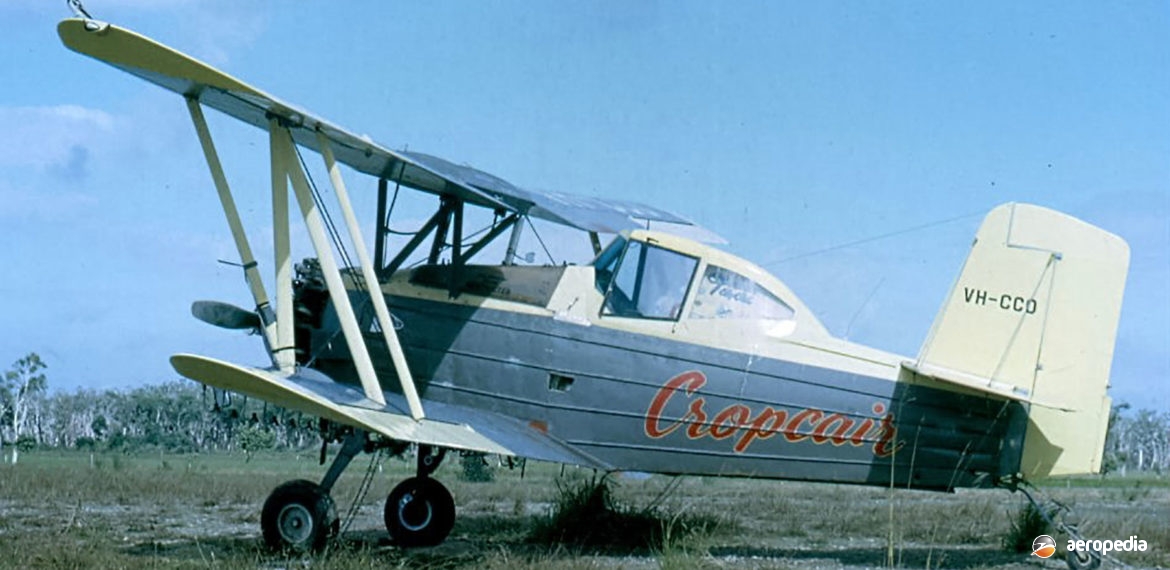Photograph:
Grumman G-164 AgCat VH-CCO (c/n 4775) at Maroochydore, QLD in July 1969 (David C Eyre)
Country of origin:
United States of America
Description:
Single-seat agricultural biplane
Power Plant:
[G-164] One 164 kw (220 hp) Continental R-670 seven-cylinder air-cooled radial engine
[G-164A] One 336 kw (450 hp) Pratt & Whitney R-985 nine-cylinder air-cooled radial engine, or
One 448 kw (600 hp) Pratt & Whitney R-1340 nine-cylinder air-cooled radial engine
Specifications:
- [G-164A]
- Wingspan: 10.9 m (35 ft 8 in)
- Length: 7.1 m (23 ft 4 in)
- Height: 3.3 m (10 ft 9 in)
- Wing area: 30.3 m² (326 sq ft)
- Max speed at sea level: 222 km/h (138 mph)
- Economical cruising speed: 161 km/h (100 mph)
- Operating speed 129 to: 161 km/h (80 to 100 mph)
- Initial rate of climb: 329 m/min (1,080 ft/min)
- Empty weight: 1,220 kg (2,690 lb)
- Loaded weight: 2,041 kg (4,500 lb)
- Max weight in restricted category: 2,756 kg (6,075 lb)
History:
The Grumman G-164 AgCat was designed by Grumman Aircraft and manufactured by Schweizer Aircraft Corporation of Elmira, New York State, under a manufacturing agreement. The prototype of the AgCat (N74054) was flown for the first time on 27 May 1957. The first two aircraft were built by Grumman but later in 1957 the Company contracted with Schweizer Aircraft Corporation to build the next 100 aircraft. The first of these (N10200) was flown on 17 October 1958. The engine fitted to early aircraft was the 164 kw (220 hp) Continental W670-6N seven-cylinder radial. By early 1980, more than 2,000 examples had been built.
A single-seater, the AgCat consisted of an all-metal airframe with duralumin and fabric-covered wings, a duralumin-covered fuselage, and fabric-covered tail. The upper and lower wings were interchangeable and a 544 kg (1,200 lb) load could be accommodated in the 3.07 m³ (29 cub ft) hopper in the G-164. In the G-164A Super AgCat, the hopper could carry up to 907 kg (2,000 lb) or 1,123 litres (247 Imp gals) of agricultural chemicals. The wing was designed with maximum lift using minimum wingspan so that the aircraft could make a continuous 1.5 G turn at dusting speed at its all-up weight. Production of the G-164A Super AgCat began in 1966 with c/n 401 (N895X) and ended at c/n 1730 (N6894Q).
A number of engines could be, and have been, fitted to the type including the 164 kw (220 hp) Continental W670-6A, W670-6N or W670-16 radial engine, the 179 kw (240 hp) Gulf Coast W670-240 radial (a modified Continental tank engine) ot the 183 kw (245 hp) engine, and the 205 kw (275 hp) or 224 kw (300 hp) Jacobs R755 A2M1 engine. Later another variant appeared with greater capacity, the G-164A with a 336 kw (450 hp) Pratt & Whitney R-985 radial engine. In 1969 the lower-powered models were discontinued, and thus the smallest engine available from that time was the 336 kw (450 hp) Pratt & Whitney R-985.
In 1974 the G-164B appeared with either the Pratt & Whitney R-985 or R-1340 engine, this model having a broad cord fin and rudder. Over 800 examples were built.
In 1980 a new variant appeared, known as the Twin Cat. This was the normal AgCat fitted with two 269 kw (360 hp) turbocharged Lycoming TIO-540-J engines flat-rated to 231 kw (310 hp). The engines were fitted as close together as the propeller diameters allowed on the bottom wing, and a nose cone was fitted. In 1976 Schweizer introduced the G-164C with a lengthened fuselage. Schweizer built 1,400 AgCats between 1959 and 1975.
In January 1981 Schweizer Aircraft Corporation of New York purchased the rights to the design from Gulfstream American (which Grumman had become). Models available at the end of 1986 were: AgCat Super-B/600 with a 448 kw (600 hp) Pratt & Whitney R-1340 nine-cylinder radial engine; AgCat Super-B/450 with a 336 kw (450 hp) Pratt & Whitney R-985 nine-cylinder radial engine; and AgCat Turbine (G-164D Cat D) fitted with either the 373 kw (500 shp) Pratt & Whitney Canada PT6A-11AG or 560 kw (750 shp) PT6A-34AG turboprop.
More recently Mid-Continent Aircraft Corporation of Hayti, Minnesota obtained certification to re-engine a number of AgCats with the 895 kw (1,200 hp) Wright R-1820-202A radial engine, this providing a maximum take-off weight of 3,855 kg (8,500 lb), this model becoming known as the King Cat.
Quite a number of AgCats have appeared on the Australian and New Zealand registers over the years but not all have been used on agricultural duties. In Queensland two VH-KKD (c/n 286) and VH-CCK (c/n 318) had a two-seat cockpit in place of the hopper and have been used for scenic flights along the Gold Coast, initially flying from Coolangatta with wheels but later being fitted with floats . VH-CCK was later returned to wheels and operated on similar tourist flights land-based.
These two AgCats were shipped overseas for a period and starred in the film ‘The Phantom’. VH-KKD remained on floats and by 2016 was operating for six months a year from Townsville, QLD and for the other six months was operating in Western Australia on tourist flights.
Examples have been converted for similar tourist flight duties in New Zealand, including ZK-CAT (c/n 1418) with Frontair and ZK-MEW (c/n 738 – ex-VH-JBB) with The Sky’s The Limit. One used in the agricultural role ZK–SJA (c/n 770B) was converted to turbine power.
In 1965 a G-164 was imported to New Zealand for a sales tour, this becoming ZK-CLQ (c/n 323) which had a 224 kw (300 hp) Jacobs engine. However, it only remained for a short period and was exported to Australia as VH-CCR. Some 22 have remained registered in Australia and four in New Zealand.
A few AgCats operated in military markings. No 359 Mira (Squadron) of the Hellenic Air Force operated a fleet of AgCats and PZL Dromaders on behalf of the Ministry of Agriculture for crop-spraying, defoliation, pest-control and firefighting, some 50 aircraft being obtained.

